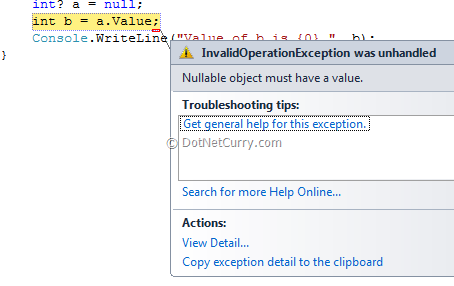x is the first operand which is a variable of a nullable type.
y is the second operand which has a non-nullable value of the same type.
While executing code, if x evaluates to null, y is returned as the value. Also remember that the null coalescing operator (??) is right-associative which means it is evaluated from right to left. So if you have an expression of the form x ?? y ?? z, this expression is evaluated as x?? (y?? z).
Note: Other right-associative operators are assignment operators, lambda and conditional operators.
Now with an overview of the C# Null Coalescing operator, let us see how to use the Null coalescing operators in practical scenarios.
Scenario 1 – Assign a Nullable type to Non-Nullable Type
Consider the following piece of code where we are assigning a nullable type to a non-nullable type.

C# Nullable Type
In the code above, if the nullable type (in our case ‘a’) has a null value and the null value is assigned to a non-nullable type (in our case ‘b’), an exception of type InvalidOperationException is thrown, as shown below:

Read more: net curry .com
QR:


